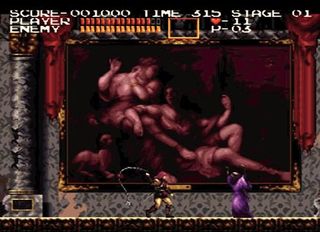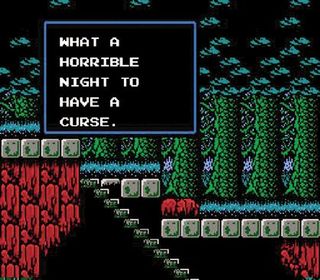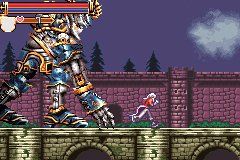10,000 years of Castlevania
A timeline of Dracula's curse as chronicled in more than 20 years of games
1691
Dracula’s most famous return – a story retold time and time again – occurred in 1691. Again he returned for his once-a-century European tour, and again his undead legions wrought havoc only for a Belmont to rise against him. Soleiyu’s great grandson, Simon Belmont, fought his way to Dracula’s throne room and again killed the count, but in death Dracula cursed Simon, committing him to a protracted and painful death which would bring an end to the Belmont bloodline.
Vampire Killer (MSX, 1986)
Castlevania (NES, 1986)
Haunted Castle (Arcade, 1988)
Super Castlevania IV (SNES, 1991)
Castlevania Chronicles (Sharp X680000, 1993 and PlayStation, 2001)

Above:Screen from PlayStation remake
Yep, Simon Belmont’s story has been retold a number of times – first in the Japanese-exclusive MSX game and then in the NES remake. It was later remade three times and re-released in various forms, but it’s the SNES Super Castlevania IV version you’re most likely to have played and the final Playstation remake of Castlevania Chronicles that’s considered definitive, with its updated Symphony of the Night-style graphics and rendered cut scenes.
1698
As the years rolled by, Simon became sick; a sickness which presumably affected his ol’ fella too, since he was yet to father an heir. To lift the curse, Simon would be forced to recover Dracula’s body and set it ablaze. However, Dracula’s disciples had retrieved the corpse and divided it between them. At the cost of an early resurrection, Dracula had guaranteed his body would be safe so that he might return to a Belmont-free world in 1791.Simon Belmont walked the land and hunted the vampire’s minions, freeing enslaved towns along the way. Once the five pieces were secured, Belmont resurrected the count and put him to death one more time...
Castlevania II: Simon’s Quest (NES, 1987)

A non-linear adventure with RPG mechanics and Metroid-style adventuring, Simon’s Quest is often considered the prototype for what Castlevania would eventually become after Symphony of the Night. In fact, the Japanese MSX version of the original Castlevania had experimented with the adventuring mechanics a year earlier, making the linear ‘classic’ Castlevania games the true anomalies in the series.
Sign up to the GamesRadar+ Newsletter
Weekly digests, tales from the communities you love, and more
1748
50 years after Simon’s Quest, Juste Belmont and Maxim Kischine headed into a mysterious castle to rescue their abducted friend Lydie Erlanger. Inside, Maxim revealed that like Simon, he had gathered Dracula’s body parts and resurrected him to prove himself worthy of the Vampire Killer. Immediately Dracula possessed Maxim and restored the castle, so Juste destroys the Count, freeing both friends and reducing the castle to ruins.
Castlevania: Harmony of Dissonance (GBA, 2002)

The second of the GBA Castlevania games again lifts the Symphony of the Night template – a 2D adventure in which you gather weapons and equipment while exploring Dracula’s castle. It divides the castle into dark and light worlds in a system which made the castle a frustrating maze, but the game was well received at the time for reasons we can’t quite fathom.
1791
Dracula reborn.
1792
Dracula returns of course, and spends a year observing Richter Belmont and plotting against him. In 1792 he stole away Richter’s girlfriend Annette Renard, and her sister Maria. After rescuing Maria, the two fought side-by-side against Dracula, but like Christopher Belmont in 1576, the pair allows Dracula to escape as mist. Severely weakened, the Count would again sleep and recover his strength.
Dracula X: Rondo of Blood (PC Engine, 1993)
Castlevania: Dracula X / Vampire’s Kiss (SNES, 1995)
Castlevania: Dracula X Chronicles (PSP, 2007)

Above: Screen from PSP version
The last of the ‘classic’ titles and the last Castlevania until the series was reimagined in Symphony of the Night, Rondo of Blood is among the best, though the SNES remake was weaker than the Japanese PC Engine original. Rondo of Blood finally saw a proper western release on the PSP with a full 3D remake in 2007.
Most Popular


